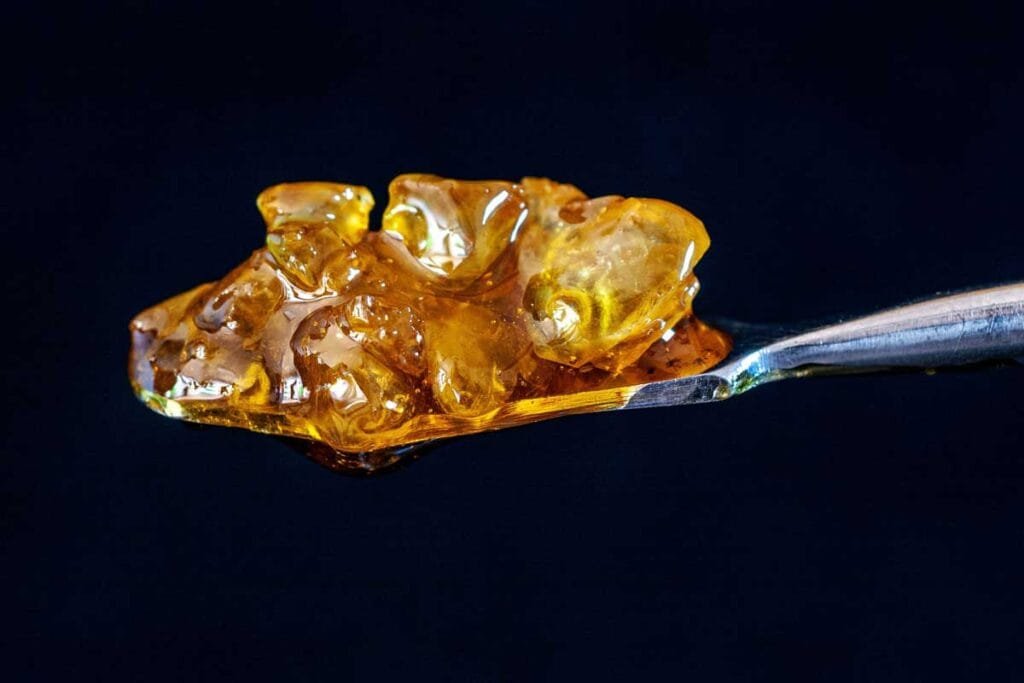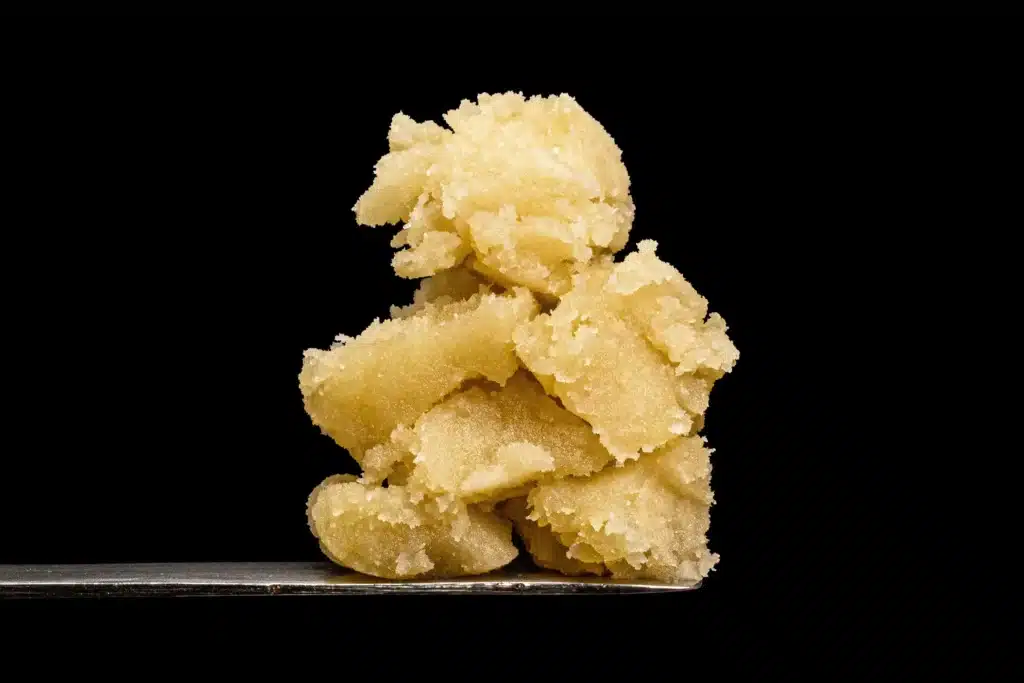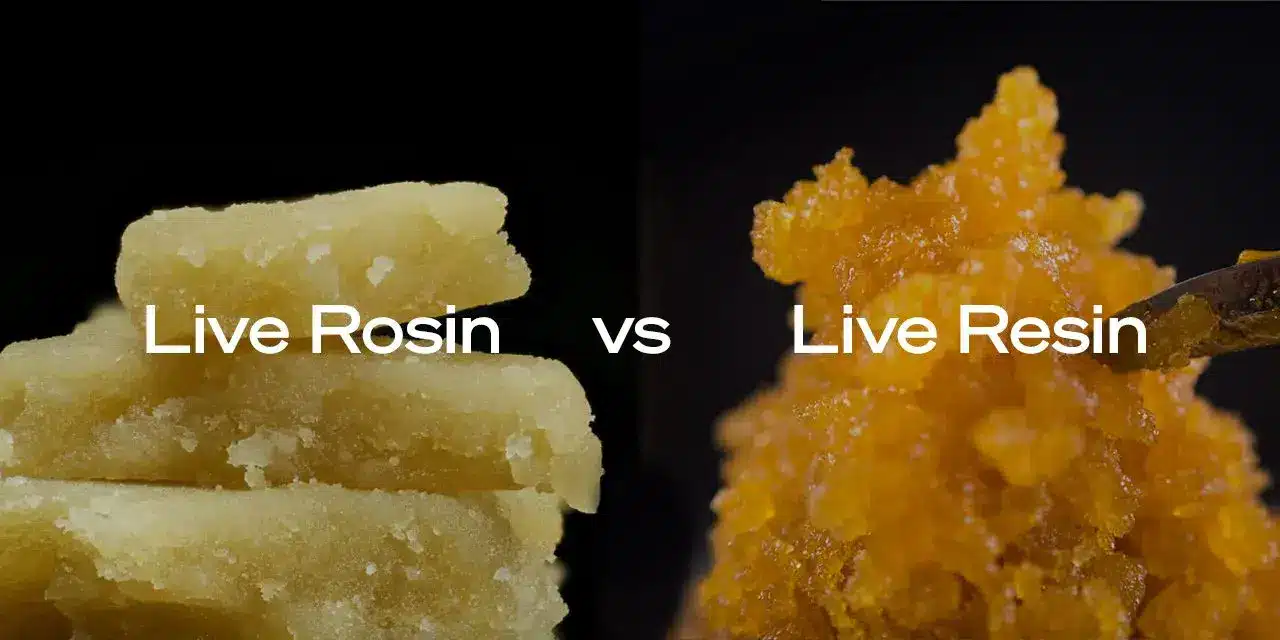With the increasing legalization of cannabis across the US states, the market of cannabis concentrates has exploded with innovation. Vaping and dabbing are the two most popular methods of smoking cannabis. There is a rising number of potent and flavorful options, but live rosin and live resin are preferred by consumers.
Live resin and rosin are highly concentrated forms of cannabis that have become increasingly important for both recreational and medicinal users. However, the live resin vs rosin debate often confuses users. In this detailed guide, we will understand the difference between resin and rosin and try to settle the debate on rosin vs. live resin.
Let’s start with the basics first.
Sections
ToggleWhat Is Rosin?

Rosin is a solventless cannabis concentrate produced by hard pressing the cannabis plant material under heat and pressure. This method produces a sticky resin known as Rosin. Free from any chemical solvents, rosin is highly potent and flavorful.
Traditionally, rosin is made using a hydraulic press. The process involves placing cannabis flower, kief, or hash between two heated plates and applying pressure. Due to heat and pressure, the trichomes melt and separate from the plant material, resulting in a golden, sap-like substance.
Consumers use rosin mostly for smoking joints, including dabs and vape cartridges. However, due to its purity, potency, and full-spectrum effects, it is also used as an edible additive. Learn More about How Is Rosin Made.
What Is Live Rosin?

A common question is what is live rosin. Simply put, live rosin is a premium form of rosin that is extracted from fresh frozen cannabis plants instead of dried and cured buds. As fresh plant material is used in the process, the term “live” is added.
The plant material is frozen immediately after harvest to produce live rosin, preserving the plant’s original terpene and cannabinoid profile. Due to this difference in the starting material, live rosin has a more similar plant’s living chemical profile, resulting in enhanced flavor, aroma, and effects.
The Live Rosin Extraction Process
The production of live rosin is a simple, multi-step process. The process prioritizes quality and purity; it starts with the following:
- Harvest and Flash Freeze: Cannabis flowers or kief are immediately flash-frozen (bubble hash) after harvest to preserve their terpene and cannabinoid content.
- The frozen bubble hash is placed in a rosin bag (25µm).
- The rosin bag is placed inside a parchment paper and between the heated plates of the rosin press.
- Further heat and pressure are applied.
- The hash resin flows from the material onto the parchment paper.
- The live rosin can be cold-cured for storage.
As the extraction process is entirely solventless, there are several advantages:
- No chemical adulteration due to solvent residue
- High purity also results in high potency
- The process maintains the plant’s original terpene profile
- Results in enhanced flavor and effects
- No risk of residual chemicals
Know the Difference: Live Rosin vs Live Resin
The Terpene Profile and Flavor of Live Rosin
One of the reasons why live rosin is so popular among users is its exceptional terpene profile. Terpenes are the aromatic compounds found in cannabis plants that add flavor, aroma, and therapeutic effects.
In the traditional extraction process, as the cannabis plants are dried, the majority of the terpene profile is lost. However, using fresh frozen material preserves most of the terpene profile, resulting in a full-spectrum flavor. It also contributes to the entourage effect, which is when various cannabis compounds work synergistically to produce more profound effects on the user. Live rosin has the most robust and diverse terpene profile compared to other extraction methods.
Potency and Effects of Live Rosin
Live rosin has high potency due to the presence of high Delta-9-tetrahydrocannabinol, also known as THC. It is the principal psychoactive compound found in cannabis plants that gives them psychedelic and therapeutic properties. Live rosin is found to have 75% to 85% THC, sometimes even higher, which is a highly potent level. The levels can be higher depending on the quality of the starting material and the extraction process.
However, the potency of live rosin is not just about the THC content. It is also highly effective because of its high terpene levels and full-spectrum nature. It gives users a more vibrant high compared to other concentrates. The full-spectrum profile is particularly useful for therapeutic applications as it may enhance the medicinal properties of rosin.
The Cost of Live Rosin
Live rosin is a premium product sold at a higher price in dispensaries than other concentrates. According to the BDSA data, live rosin can command a price of up to $30 per gram. However, the cost of live rosin depends on several factors, including:
- Quality of the cannabis plant used
- Terpene profile of the starting material
- Labor costs depend on the process of extraction
- Cost of specialized equipment such as high-quality presses
However, the high cost compares to the purity, potency, and superior flavor. These factors make live rosin worth the investment as a top-tier, solventless concentrate.
Now that we’ve explored live rosin let’s move ahead with our resin vs. rosin comparison and explore live resin.
What Is Live Resin?

Live resin is another form of cannabis concentrate extracted from fresh, frozen cannabis plants. While the starting material is the same as live rosin, live resin is extracted using another method.
A light hydrocarbon extraction process produces live resin using butane or propane. Due to the use of butane in the process, live resin is also known as a premium type of butane hash oil (BHO). In appearance, live resin has an amber color and a soft, sugary texture.
Compared to other resins, live resin has the highest level of THC profile. It also has a more profound terpene profile, making it more effective and aromatic.
How Live Resin Is Made
Live resin is produced using a hydrocarbon extraction process using butane or propane. Here’s a step-by-step extraction process:
- Frozen cannabis material is submerged in a solvent (mostly butane) in a tank in a closed-loop hydrocarbon extraction system.
- The solvent dissolves the cannabinoids and terpenes.
- The solvent is then passed into the collection tank.
- Dark cannabis oil from the collection tank is filtered using a color remediation column (CRC). It lightens the color and removes contaminants. However CRC is one of the options and some users may prefer not to use CRC due to the fact that it will retain cannabinoids and terpenes in the filter media. Instead of using CRC, operators can adjust extraction parameters to achieve the color they desire while maintaining the true flavor and cannabinoid profile.
- Once above is done, the solvent is purged from extracting using a vacuum oven.
- Live resin can be further processed for higher purity.
Live resin is more popular than other resins extracted from dried plant material because of its rich terpene and cannabinoid profile. By retaining a high level of terpene profile, live resin maintains high potency.
Due to the increased demand for live resin products, the industry is witnessing innovation in the extraction process. Improved closed-loop systems are becoming an industry standard as they minimize solvent exposure.
The Terpene Profile and Flavor of Live Resin
The rich terpene profile is the hallmark of live resin. The extraction process uses fresh frozen plant material at a low temperature, so live resin preserves a wide array of terpenes. Other forms of resins lose most of the terpenes during drying and curing.
High terpene concentration means incredible aroma and flavor. Consumers often find the flavor of live resin more complex compared to other concentrates, resembling the aroma of fresh cannabis plants. It results in higher potency, more pronounced entourage effects, and boosted overall experience for the user.
Potency and Effects of Live Resin
Depending on the parameters of the extraction process, live resin can have THC levels ranging from 65% to 85%. However, as with live rosin, the effects of live resin are not solely determined by its THC content. The effects also depend on what type of terpene is present in live resin, as different terpenes are associated with various effects.
Preservation of the plant’s full spectrum of compounds, such as minor cannabinoids and terpenes, gives a more “complete” effect to users, ranging from relaxation to enhanced focus.
The difference is subtle but essential to understand when comparing the effects of live resin vs. live rosin. Live rosin is the purer form with no solvent present. Also, due to its high potency, live rosin has longer-lasting effects. However, live resin provides a more intense initial effect due to hydrocarbons. The final effects depend on specific products and individual tolerance.
Some users prefer live rosin for its purity, while others go with live resin as it is more affordable.
The Cost of Live Resin
While still a premium product, live resin is generally available at a cheaper price. On average, live resin costs $20 per gram. However, there are several factors influence its price:
- Live resin is cheaper because solvent-based extraction typically yields more product per gram compared to rosin pressing.
- Industrial production of live resin is easier.
- Automated equipment makes live resin production less labor-intensive than live rosin production.
Live resin is still costlier than other resins but more affordable than live rosin. It allows users to enjoy fresh frozen material quality at a cheaper price. However, price should not discourage any user from purchasing live resin from reputed dispensaries. Stay away from unknown brands or unlicensed sellers.
Live Rosin vs Live Resin: Which Is Better?
The debate of live rosin vs live resin is ongoing in the cannabis community, and there is no winner. You will find passionate advocates on both sides and terming one form “better” is not rational. It depends on personal preference, as each has its own strengths and ideal use cases.
Let’s compare both on essential parameters:
- Potency: Live rosin and live resin have high potency. Live resin can easily have a higher THC percentage, but live rosin preserves a higher full-spectrum profile.
- Flavor: While both forms excel in flavor, the absence of any solvent gives live rosin a better flavor. It also preserves even the most delicate terpenes.
- Cost: Live resin is generally more affordable compared to live rosin.
- Effects: Both forms offer potent effects. Live rosin provides a “cleaner” high, while live resin might offer more intense initial effects.
Apart from the effect profile, use also depends on the application’s purpose. The purest possible product, i.e., live rosin, is a better choice for medicinal users. The same goes for flavor chasers, as live rosin has an unadulterated terpene profile. However, recreational users looking for intense effects at a lower price point might lean towards live resin.
How to Choose Between Live Rosin and Live Resin
When deciding between live rosin vs live resin, the choice should consider several factors. Some important considerations include:
- Potency: What THC concentration do you want? If maximum THC content is your priority, live resin is better. However, live rosin could be the better choice if you’re interested in a more balanced, full-spectrum experience.
- Flavor: Both offer exceptional flavor. Still, for most unadulterated cannabis experiences, live rosin is better than live resin.
- Cost: If cost is a significant concern, live resin is generally a more affordable option. Please note that irrespective of your budget, you must always buy cannabis products from licensed dispensaries to ensure safety and purity.
- Intended Use: If you want cannabis for medical use, live rosin is best, as there will be no solvent residue. For recreational purposes, live resin might be better.
- Availability: Depending on your location, availability might be a concern.
When considering any product, look for expert opinions and user testimonials. Pros and cons are associated with each type of product, and opinions on the live resin vs rosin debate vary. Look for testimonials that have a similar intended use to yours.
Exploring Different Types of Live Resin and Rosin
You will seldom find live resin or rosin in its raw form as they are produced. Rather, markets have different forms of products, each with unique characteristics.
- Sauce: It is a terpene-rich, liquid form with THCA crystals. It is in the form of an amber tarry liquid with low cannabinoids but high terpenes.
- Badder/Budder: Another terpene-heavy cannabis concentrate, this form of resin or rosin, has a smooth, butter-like consistency. It seems like cookie dough or yellow-brown cake frosting.
- Sugar: A crystalline form of live rosin or resin, it resembles wet sugar. It is also known as live sugar and resembles sugar granules in honey globs.
The storage and consumption practices may differ depending on which type of product you use. Generally, live resin and rosin products are used in vapes or dabs. Low-temperature dabbing is often preferred to preserve flavor and potency. It is often recommended to store all forms in a cool, dark place in an airtight container.
Determining Dosage of Resin and Rosin Products
Finally, you should also understand the dosage of live resin and live rosin. It is crucial because both forms are high cannabis concentrates. There are several factors to consider:
- Individual tolerance
- Desired effects
- Consumption method
- Product potency
Beginners must start with a very small amount. For example, a dab the size of a pinhead is often sufficient for first-time users. Experienced users may use larger amounts but should be cautious, especially when trying a new product.
Ensure to stick with these safety best practices:
- Do not dose too many times; wait at least 15-20 minutes between doses
- Use proper dabbing or vaping equipment to better control temperatures
- Be aware of your surroundings and never operate machinery or drive under the influence
Storing and Preserving the Quality of Live Rosin and Resin
Whatever type of product you use, both live rosin and resin must be preserved under controlled conditions to maintain their quality and integrity.
Here are the recommended storage settings:
- Store the product in a cool environment, ideally around 60-70°F (15-21°C).
- Keep products away from direct light, as exposure to light degrades cannabinoids and terpenes.
- Use airtight containers to prevent oxidation of content.
- Maintain a low humidity in storage cabinets to prevent degradation.
Some common mistakes that can degrade the quality of the product:
- Leaving containers open
- Storing products in warm areas (e.g., near electronics)
- Exposing containers to frequent temperature fluctuations
As these products have very low water content, they can have a shelf life of several months with proper storage. Still, depending on the product, consuming it within 3-6 months of purchase is advisable. If the product shows changes in color, consistency, or aroma, these are signs of degradation.
Conclusion
Live rosin and live resin are the most popular forms of cannabis concentrates, offering a premium experience. While both are produced from fresh frozen cannabis, there are several differences in products. Live rosin is known for its solventless purity and unadulterated flavor profile, making it suitable for medical users and purists. On the other hand, live resin offers high potency and complex flavors for a more affordable price, appealing to a wide range of consumers.
The choice between live resin vs rosin ultimately comes down to personal preference, budget, and intended use. We recommend considering your preferences, starting low, and consuming responsibly.




